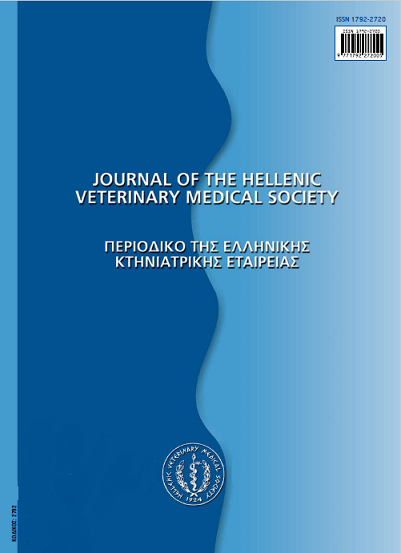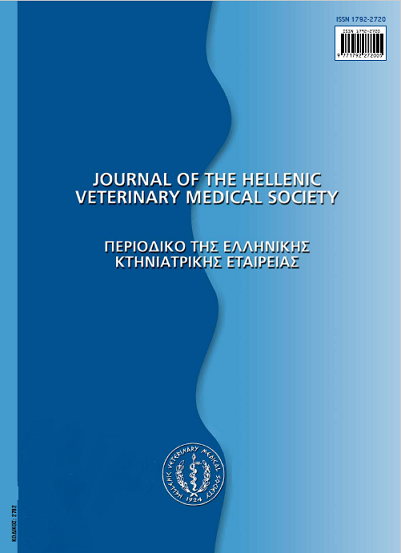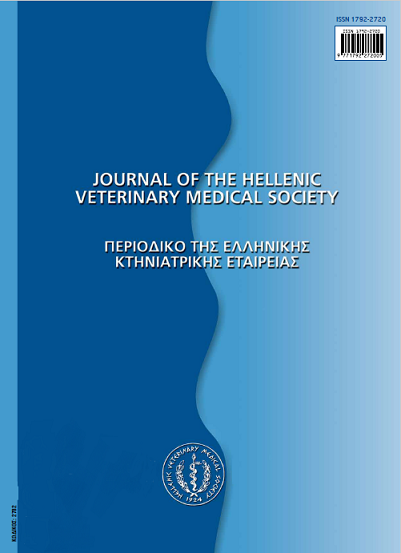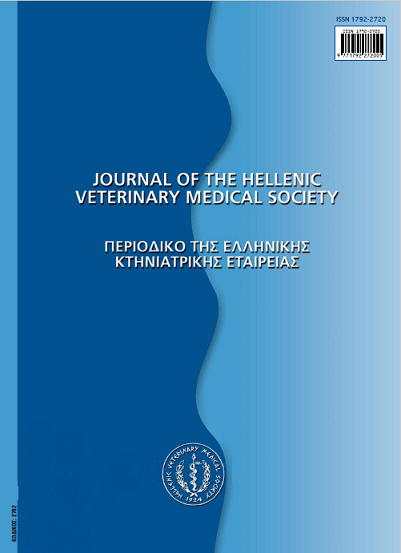Αξιολόγηση μιας συσκευής εμπλουτισμού του περιβάλλοντος στέγασης των εργαστηριακών κονίκλων

Περίληψη
Η βελτίωση των συνθηκών στέγασης των ατομικά στεγαζόμενων κονίκλων που χρησιμοποιούνται στη βιοϊατρική έρευνα με τη χρησιμοποίηση αντικειμένων που εμπλουτίζουν το περιβάλλον στέγασης αποτελεί αντικείμενο ιδιαίτερου ενδιαφέροντος για την επιστημονική κοινότητα και υποστηρίζεται από σχετικές οδηγίες αντίστοιχων επιστημονικών οργανισμών αλλά και από τη νομοθεσία. Σκοπός της συγκεκριμένης εργασίας ήταν να αξιολογήσει τον τρόπο με τον οποίο ατομικά στεγαζόμενοι κόνικλοι αλληλεπιδρούν με ένα εμπορικά διαθέσιμο αντικείμενο που μπορεί να χρησιμοποιηθεί σαν φωλιά στη διάρκεια
της περιόδου ανάπαυσης του ζώου. Για τη συγκεκριμένη εργασία χρησιμοποιήθηκαν εξι (6) αρσενικοί κόνικλοι, φυλής Νέας Ζηλανδίας και μέσου σωματικού βάρους 2,5 κιλών. Μετά από περίοδο εγκλιματισμού πέντε ημερών στο δωμάτιο στέγασης, μια φωλιά με την εμπορική ονομασία Rabbit Hut, τοποθετήθηκε σε κάθε κλουβί. Μετά από περίοδο εξοικείωσης τριών ημερών με το αντικείμενο ξεκίνησε η καταγραφή των ζώων μέσω κάμερας, συνδεδεμένης με ηλεκτρονικό υπολογιστή, κατά τη διάρκεια της φωτεινής περιόδου (06:00 – 18:00) για συνολική περίοδο πέντε ημερών. Από την παρατήρηση προκύπτει ότι τα ζώα χρησιμοποιούσαν το αντικείμενο για διαφόρους λόγους όπως να περάσουν ή να καθίσουν από κάτω, να το δαγκώσουν, να το τραβήξουν καθώς και για άλλους χειρισμούς. Αυξημένη αλληλεπίδραση του ζώου με το αντικείμενο καταγράφηκε στην αρχή και στο τέλος της φωτεινής περιόδου. Συμπερασματικά, αν και η υπό έλεγχο συσκευή φαίνεται να είναι κατάλληλη προκειμένου να χρησιμοποιηθεί για τον εμπλουτισμό του περιβάλλοντος των κονίκλων που χρησιμοποιούνται για ερευνητικούς σκοπούς, εντούτοις περαιτέρω διερεύνηση απαιτείται προκειμένου να διευκρινιστεί αν ορισμένοι χειρισμοί που καταγράφησαν αποτελούν εκδήλωση περιέργειας, ενδιαφέροντος ή εκνευρισμού.
Λεπτομέρειες άρθρου
- Πώς να δημιουργήσετε Αναφορές
-
KOSTOMITSOPOULOS (Ν. ΚΩΣΤΟΜΗΤΣΟΠΟΥΛΟΣ) N., SERAFETINIDOU (Μ. ΣΕΡΑΦΕΤΙΝΙΔΟΥ) M., KATSAROU (Α. ΚΑΤΣΑΡΟΥ) A., VOYAZAKI (Χ. ΒΟΓΙΑΤΖΑΚΗ) C., & DONTAS (Ι. ΔΟΝΤΑ) I. (2017). Αξιολόγηση μιας συσκευής εμπλουτισμού του περιβάλλοντος στέγασης των εργαστηριακών κονίκλων. Περιοδικό της Ελληνικής Κτηνιατρικής Εταιρείας, 66(1), 41–47. https://doi.org/10.12681/jhvms.15582
- Τεύχος
- Τόμ. 66 Αρ. 1 (2015)
- Ενότητα
- Research Articles
Οι συγγραφείς των άρθρων που δημοσιεύονται στο περιοδικό διατηρούν τα δικαιώματα πνευματικής ιδιοκτησίας επί των άρθρων τους, δίνοντας στο περιοδικό το δικαίωμα της πρώτης δημοσίευσης.
Άρθρα που δημοσιεύονται στο περιοδικό διατίθενται με άδεια Creative Commons 4.0 Non Commercial και σύμφωνα με την άδεια μπορούν να χρησιμοποιούνται ελεύθερα, με αναφορά στο/στη συγγραφέα και στην πρώτη δημοσίευση για μη κερδοσκοπικούς σκοπούς.
Οι συγγραφείς μπορούν να καταθέσουν το άρθρο σε ιδρυματικό ή άλλο αποθετήριο ή/και να το δημοσιεύσουν σε άλλη έκδοση, με υποχρεωτική την αναφορά πρώτης δημοσίευσης στο J Hellenic Vet Med Soc
Οι συγγραφείς ενθαρρύνονται να καταθέσουν σε αποθετήριο ή να δημοσιεύσουν την εργασία τους στο διαδίκτυο πριν ή κατά τη διαδικασία υποβολής και αξιολόγησής της.









